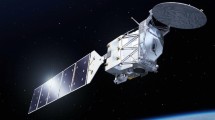Abstract
From past many decades, the integrating nephelometers are generally used to measure the aerosol scattering coefficient for ground level at different wavelengths. In recent years, the research focus has been shifted toward the airborne observations using either tethered balloons or drones. For this particular purpose, one needs light-weight instruments which are capable of measuring the aerosol scattering coefficient suitable for airborne activities. Thus, we report the design and development of a light-weight scattering coefficient counter (weight ~ 500 g, 7″ × 3″) with high sensitivity. This instrument has been specifically designed and developed for the measurement of aerosol scattering coefficient at 633 nm wavelength. The aerosol scattering coefficient calculation becomes extremely important for modeling aerosol optical/radiative properties. Delhi is one of the regions with high aerosol loadings, so one needs such Light-weight instruments for the aerosol scattering coefficient measurements. At present, this instrument has only been evaluated at ground level. But, before using the developed instrument for airborne observations, there is a strong need for comparison of the instrument against routinely used nephelometers for performance evaluation. Comparisons were performed between the light-weight scattering coefficient counter and high-end AURORA 3000 Nephelometer for two different seasons. For both the seasons, i.e., the monsoon season (July 25–August 24, 2017) and the winter season (February 1–28, 2018), we found a strong correlation (i.e., R2 = 0.99). However, the highest value of scattering coefficient was found to be 98 ± 32 Mm−1 with a mean value of 55 Mm−1 for the monsoon season, while the same for the winter season was observed to be 270 ± 108 Mm−1 with a mean value of 165 Mm−1. This light-weight instrument could be a potential instrument for aerosol scattering observations, especially for airborne platforms with payload mass limitations.




Similar content being viewed by others
References
M.S. Reddy and C. Venkataraman, Atmospheric optical and radiative effects of anthropogenic aerosol constituents from India, Atmosp. Environ. 34 (2000) 4511–4523.
R. Varma, H. Moosmüller and W.P. Arnott, Toward an ideal integrating nephelometer, Opt. Lett. 28 (2003) 1007.
M.V.S.N. Prasad, C. Sharma, B.C. Arya et al., Experimental facilities to monitor various types of atmospheric parameters in the radio and atmospheric sciences division (RASD) of CSIR-National Physical Laboratory, MAPAN-J. Metrol. Soc India 28 (2013) 193–203.
S.R. Radhakrishnan, B.C. Arya, C. Sharma et al., Studies on low altitude clouds over New Delhi, India Using Lidar, MAPAN-J. Metrol. Soc India 31 (2016) 137. https://doi.org/10.1007/s12647-016-0166-4.
R.G. Beutell and A.W. Brewer, Instruments for the measurement of the visual range, J. Sci. Instrum. 26 (1949) 357–359.
J. Heintzenberg and R.J. Charlson, Design and applications of the integrating nephelometer: a review, J. Atmosp. Ocean. Technol. 13 (1996) 987–1000.
T.L. Anderson and J.A. Ogren, Determining aerosol radiative properties using the TSI 3563 integrating nephelometer, Aerosol Sci. Technol. 29 (1998) 57–69.
T. Muller, M. Laborde, G. Kassel and A. Wiedensolher, Design and performance of a three-wavelength LED-based total scatter and backscatter integrating nephelometer, Atmos. Meas. Tech. 4 (2011) 1291–1303. https://doi.org/10.5194/amt-4-1291-2011.
GRIMM 1.108, https://www.wmo-gaw-wcc-aerosol-physics.org/files/opc-grimm-model–1.108-and-1.109.pdf.
L.T. Khemani, M.S. Naik, G.A. Momin, R. Kumar, R.N. Chartterjee, G. Singh and B.V.R. Murty, Trace elements in the atmospheric aerosols at Delhi, North India, J. Atmosp. Chem. 2 (1985) 273–285.
D.S. Bisht, U.C. Dumka, D.G. Kaskaoutis et al., Carbonaceous aerosols and pollutants over Delhi urban environment: temporal evolution, source apportionment and radiative forcing, Sci. Total Environ. 521–522 (2015) 431–445.
S.L.R. Ellison, M. Rosslein and A. Williams, Quantifying uncertainty in analytical measurement. EURACHEM/CITAC (2000).
S.G. Aggarwal, Recent developments in aerosol measurement techniques and the metrological issues, MAPAN-J. Metrol. Soc India 25 (2010) 165–189.
N. Kayal and N. Singh, Uncertainty calculation in the quantitative estimation of silica in rice husk ash by titrimetric method, MAPAN-J. Metrol. Soc India 25 (2010) 115–123.
International vocabulary of metrology-basic and general concepts and associated terms (VIM) (2008).
Ecotech, Aurora 3000 User manual 1.3 (2009).
A. Ahlawat, S.K. Mishra, S. Gumber, V. Goel, C. Sharma and A. Wiedensohler, Performance evaluation of light weight gas sensor system suitable for airborne applications against co-location gas analysers over Delhi, Sci. Total Environ. 697 (2019) 134016.
Acknowledgements
The authors are thankful to Director, NPL, for his consistent support for the ongoing work. Authors acknowledge CSIR Network Project AIM_IGPHim (PSC-0112) for the financial support.
Author information
Authors and Affiliations
Corresponding author
Ethics declarations
Conflict of interest
On behalf of all authors, the corresponding author states that there is no conflict of interest.
Additional information
Publisher's Note
Springer Nature remains neutral with regard to jurisdictional claims in published maps and institutional affiliations.
Rights and permissions
About this article
Cite this article
Ahlawat, A., Mishra, S.K., Gumber, S. et al. Performance Analysis of Light-weight Scattering Coefficient Counter with AURORA 3000 Nephelometer over Delhi. MAPAN 35, 213–219 (2020). https://doi.org/10.1007/s12647-019-00361-5
Received:
Accepted:
Published:
Issue Date:
DOI: https://doi.org/10.1007/s12647-019-00361-5




